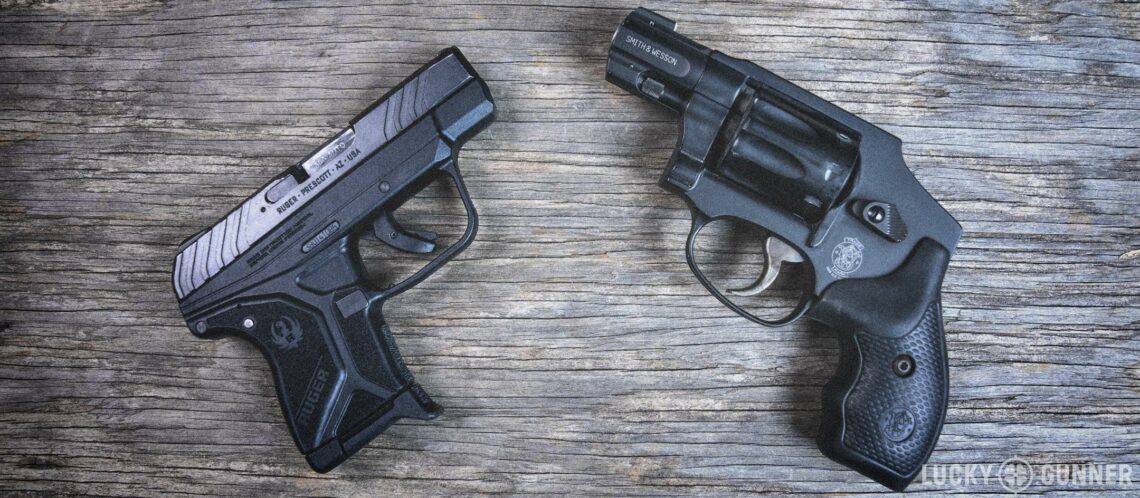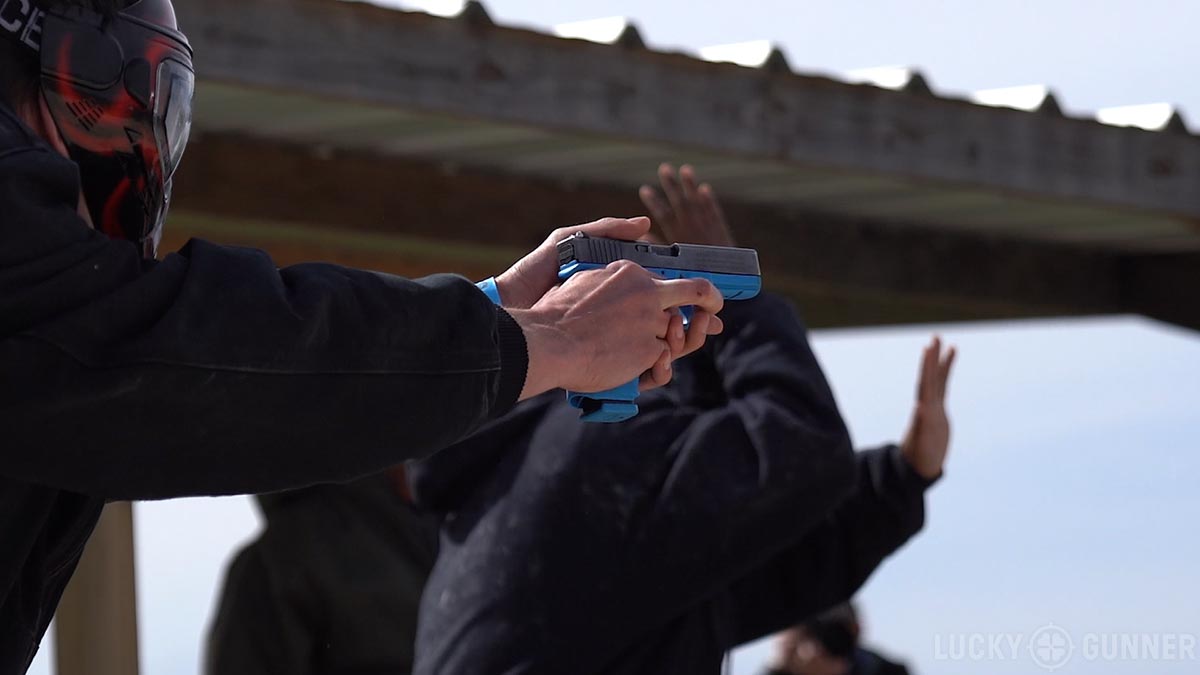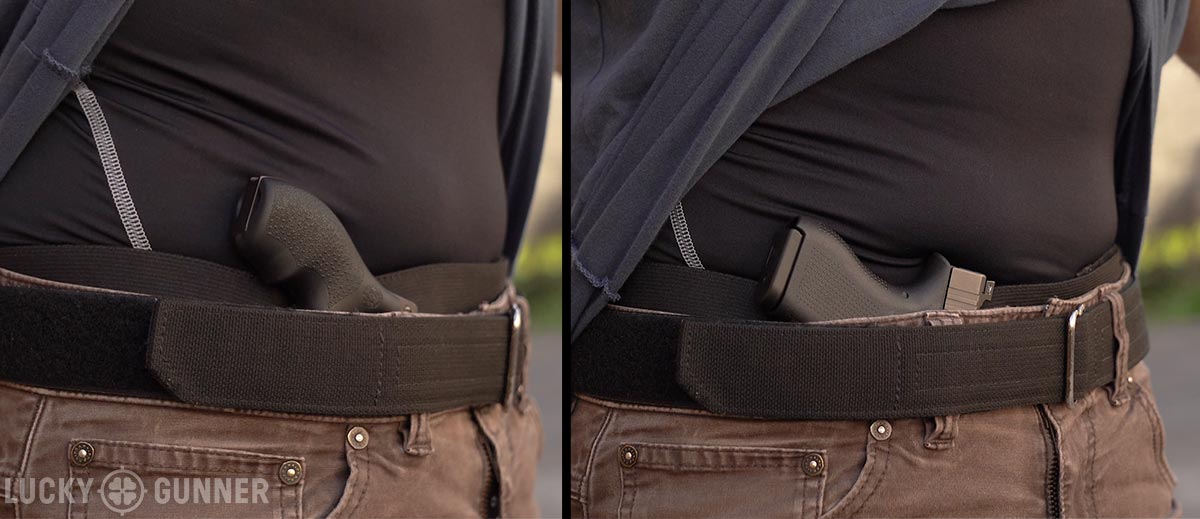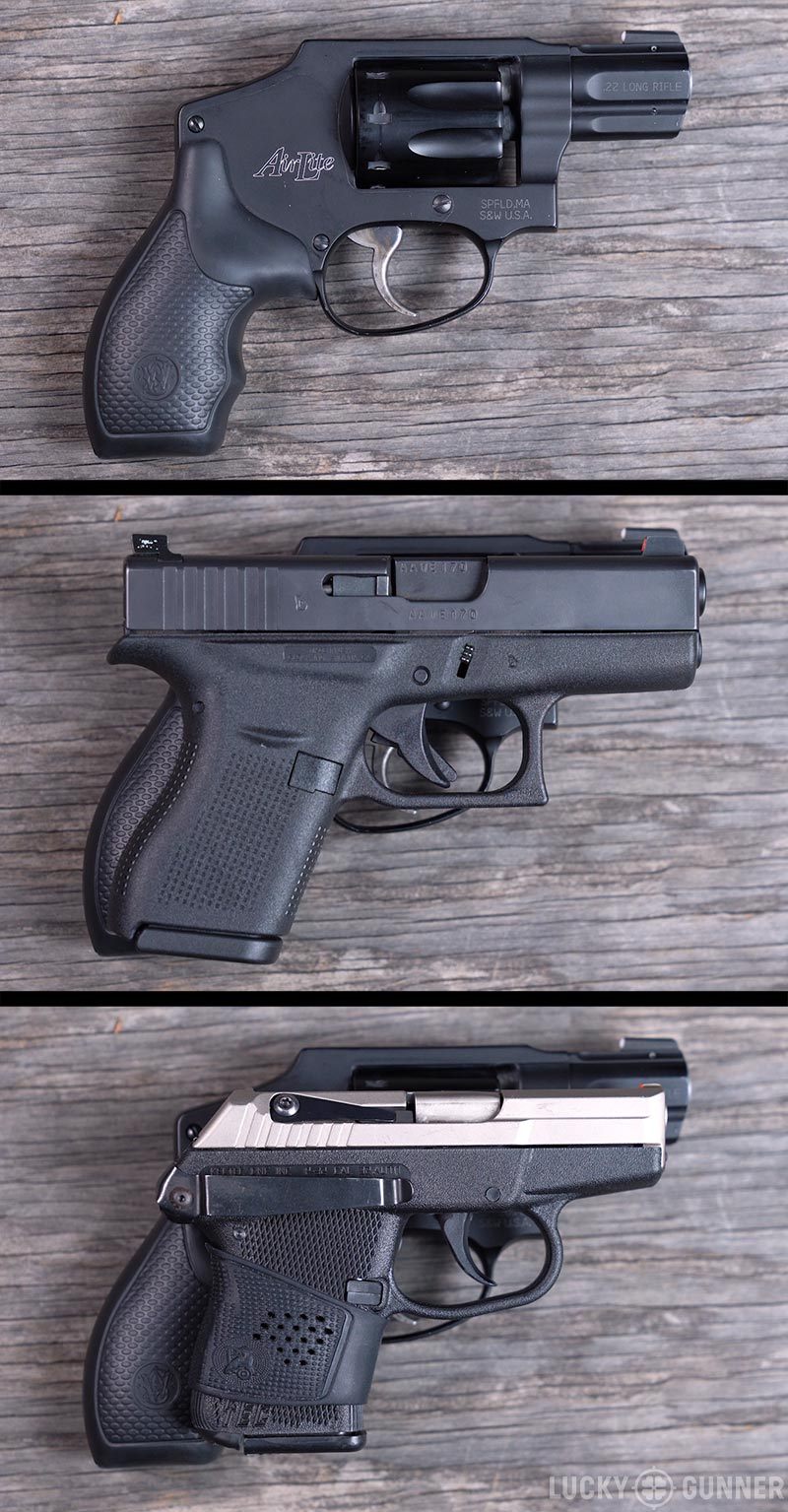How does a pint-sized semi-auto pea shooter stack up against a stumpy snubnose wheel gun? In Part 16 of our Pocket Pistol Series, we’re taking a hard look at when and why the average armed citizen might be better off with using one over the other for concealed carry. Check out the video below for the details, or just scroll on down to read the full transcript.
Our Pocket Pistol Series has been a study of both pocket-sized semi-autos and small-frame snub nose revolvers. Either type of handgun can fill the role of allowing you to be armed while minimizing the burden of carrying the gun and keeping it concealed. Beyond that, they differ quite a bit in terms of their strengths and weaknesses.
There are a lot of factors we could take into account here, but if we narrow it down to the most important ones, with a snub nose, you’re getting superior reliability and easier access to the gun, and with a pocket pistol, you’re trading those qualities in favor of a smaller gun that’s going to be easier to conceal.
Before we dig into this, I want to define our terms because “pocket pistol” and “snub nose” are not clearly delineated technical terms. For the sake of this discussion, I’m going to consider a pocket pistol to be any semi-auto that’s roughly the size of a Glock 42 or smaller and chambered for calibers equal to or smaller than .380 ACP. Depending on who you ask, a snub nose can be any revolver with a barrel length under three inches. Today, I’m talking about the more narrow sub-set of small-frame lightweight snubbies with barrels around two and a half inches or less. They will have frames made of polymer or aluminum or other lightweight alloys. Primarily, I’m assuming something like a Smith & Wesson J-frame Airweight or Airlite model or a Ruger LCR.
I don’t want to spend a whole lot of time on what I’d consider to be the secondary factors when comparing pocket pistols and snubbies but I’ll touch on a few of them just briefly.
A lot of times, this discussion devolves into a debate about .380 ACP versus .38 Special. Historically, .38 is considered to have better ballistics. Neither of them are really outstanding, though. Of course there are other calibers in both platforms like the various .32s and .22s. They are all relatively weak and yet they all seem to work most of the time with good shot placement. I would not look to caliber as the deciding factor.
I’d say the same thing about ammo capacity. You’ll get about 6 to 8 rounds in a pocket pistol. Most snubbies are .38s and that will only give you five shots. If that makes you uncomfortable, go to one of the .22s or .32s and you can get 6 to 8 rounds just like a semi-auto.
Modern technology has allowed both pocket pistols and revolvers become much lighter in recent years. Fully loaded, pocket pistols typically weigh between 10 and 17 ounces. Polymer and alloy-framed revolvers are usually between 12 and 19 ounces. So not much difference there.
If cost is a major consideration for you, then pocket pistols are going to be very appealing with prices for several decent models starting between $200 and $300. But you don’t have to spend a fortune to get a snub nose, either. Basic models from Smith & Wesson and Ruger usually start between $350 and $400.
Shootability is that intangible quality that describes how easy it is to shoot a particular gun well. It is usually some combination of felt recoil, trigger, and ergonomics. I do think shootability is important, especially if you plan to actually practice with this gun. But with a few exceptions, both pocket pistols and snub nose revolvers together are among the least shootable handguns around. That’s less the case with some of the heavier models and the lighter calibers. But overall, shootability is not the best criteria for making generalizations about these two categories.
So now let’s get to the major distinguishing factors. I believe the biggest advantage a snub nose revolver has over a pocket pistol is reliability. A few people might be surprised to hear me say that because, despite being a revolver enthusiast, I have often gone out of my way to point out just how unreliable they can be sometimes, especially when you compare full size revolvers to full size semi-autos. Revolvers require more maintenance to keep them running if you shoot them a lot. They don’t hold up too well against hard impacts or being dropped. And new production revolvers seem to be highly prone to manufacturing defects.
However, under the chaotic conditions of a real world fight, a snub nose in good condition is a lot more dependable than a small semi-auto. Like I discussed last time, small semi-autos are uniquely susceptible to feeding issues when you try to shoot them with anything other than a perfect textbook stance and grip at the shooting range. In the real world, when people get taken off guard by a deadly threat and they go for their gun, weird things happen.
Here’s a great example from a force-on-force exercise I observed a few months ago. This guy has just drawn his sim gun and he’s shooting at an attacker and check out that that grip he’s got:
He somehow managed to hook the middle finger of his firing hand around the front of the trigger guard and his support hand thumb is wrapped over top of the slide. This guy knows how to grip a gun properly, but somehow he got all tangled up during his drawstroke. By some miracle, that Simunition Glock didn’t actually malfunction in that scenario, but I can almost guarantee if you tried to fire a Glock 42 or an LCP that way, you’d get off one shot and then you’d have a failure to extract.
A lot of times, these small guns are carried deep inside a pocket or a belly band or somewhere that’s not always easy to get to, and that increases your chances of getting a sub-optimal grip that could compromise the pistol’s ability to operate. The revolver, on the other hand, doesn’t care how you grip it, especially a double action only revolver like this one with a shrouded hammer. If you can pull the trigger, you can make it go bang. It’ll fire from inside a pocket, it’ll fire if it’s pressed up against the guy who’s got you pinned to the ground. If it’s a properly functioning revolver, just about the only way to make it stop mid-fight is to grab the cylinder and keep it from turning. Otherwise, a snub nose might be one of the absolute best weapons you could have in your hand in a fight at contact distance. It’s also one of the best guns you can have on you period if you need to get that gun out in a hurry. And that brings me to the next point: accessibility.
This attribute is probably the one that is most often overlooked but I think it should be near the top of the list of what you look for in a carry gun. If you ever have to use your gun to defend your life, there is a very good chance you won’t actually have to fire it. But you will have to get it out. You need to be able to do this without fumbling with cover garments or digging around in a pocket. I’m not saying you necessarily have to have a blindingly fast drawstroke, but ideally, deploying that gun is a deliberate, practiced action you can do consistently and reasonably quickly while your brain is on auto-pilot. This is where a snubby offers some advantages thanks to the size of the grip and the overall shape of the gun.
Whether it’s in a belt holster, ankle holster, a pants pocket, a purse pocket, or whatever, the snub nose revolver has a grip that is easier to get your hand around. It’s a larger grip than a pocket pistol, and it doesn’t have this obstruction in the back created by the beavertail and the slide. So if you end up having to draw the revolver from an awkward angle, you can still get a grip on it. And again, with a double action only revolver, you don’t have to worry about the back of it getting hung up if you draw it from a pocket.
What I really like about the snubbies is the grip angle. So if I want to go for maximum concealment with something like a belly band type holster, I can bury most of the gun way below the waistline and still have enough grip sticking up to get my fingers around the front strap and draw it the way I normally would. If I do that with a pocket pistol, I still have the back of the slide that I have to conceal and if I need to draw, I’m going to have to slip my hand in between the gun and my waistband. You can certainly do that, it’s just slower and less consistent.
Okay, so now let me balance the reliability and accessibility argument with the issue of size. Because a carry gun doesn’t do you any good if you don’t actually carry it.
Like I mentioned earlier, pocket pistols and snub nose revolvers are pretty close in terms of weight, but pocket pistols tend to be much smaller. If you hold a snubby up against a big pocket pistol like the Glock 42, the revolver is slightly taller and longer, and the cylinder makes it significantly wider. The difference is really stark next to a smaller pocket pistol like the Kel-Tec P32. It’s not even close. I don’t actually own a pair of pants that will conceal a J-frame in a front pocket without looking like I’ve got a tumor growing out of my leg, but I could stick a P32 in the pocket of my gym shorts without tipping anyone off.
Next to full size or even compact handguns, pocket pistols and snubbies are all pretty small and it might look like I’m splitting hairs by making this size comparison. But depending on your situation, some seemingly minor differences in the size or shape of the gun can determine whether it’s printing through your clothing or what kind of lengths you have to go to in order to make sure that gun stays concealed all day.
It’s really easy to be dismissive of the idea of carrying a smaller handgun when a different gun that we think of as being only marginally bigger might be a superior fighting tool. That’s especially true for those of us who have the luxury of dressing like slackers most of the time and who also don’t live or work in places that are hostile to concealed carry. It’s common for people like us to take the myopic perspective that convenience is the only reason someone would choose to carry a smaller gun, and if you value your life more than you value comfort, you’ll carry a more capable firearm.
There are a lot of flaws with that line of thinking, but especially the failure to consider that everyone else’s day to day reality doesn’t look like yours. A few times in this series, I’ve mentioned the idea of non-permissive environments. Those are places where it’s not illegal to carry a gun but there could be serious consequences if someone found out you were doing it. The typical example is an employer with a strict no guns policy where you risk being fired if you violate that policy. But the situation could be a lot more subtle than that. Like, it could be a real problem if you have to dress differently than everyone around you in order to conceal your gun. You can’t walk around with pants that are two sizes too big or your shirt always untucked in an office where everyone is expected to wear formal business attire.
For some of you guys, your whole town or state is basically a non-permissive environment. If anyone even suspects you might have a gun on you, permit or no permit, they’re calling the cops. You might not actually get arrested, but that’s probably not the kind of hassle you want to deal with when you’re at the dentist’s office or out buying a gallon of milk.
So personally, except for some very specific situations, when I want a small gun, I much prefer a snub nose because of the reliability and accessibility issues. I can find a way to conceal one in almost any environment I’m going to be in and I’m confident in what I can do with it. But I’m not going to say they’re always better because my once in a while exception scenario might be your everyday scenario. A pocket pistol that’s been vetted and test fired can be pretty reliable most of the time and with a well-thought out and practiced carry method, it can be easily accessible, too.





